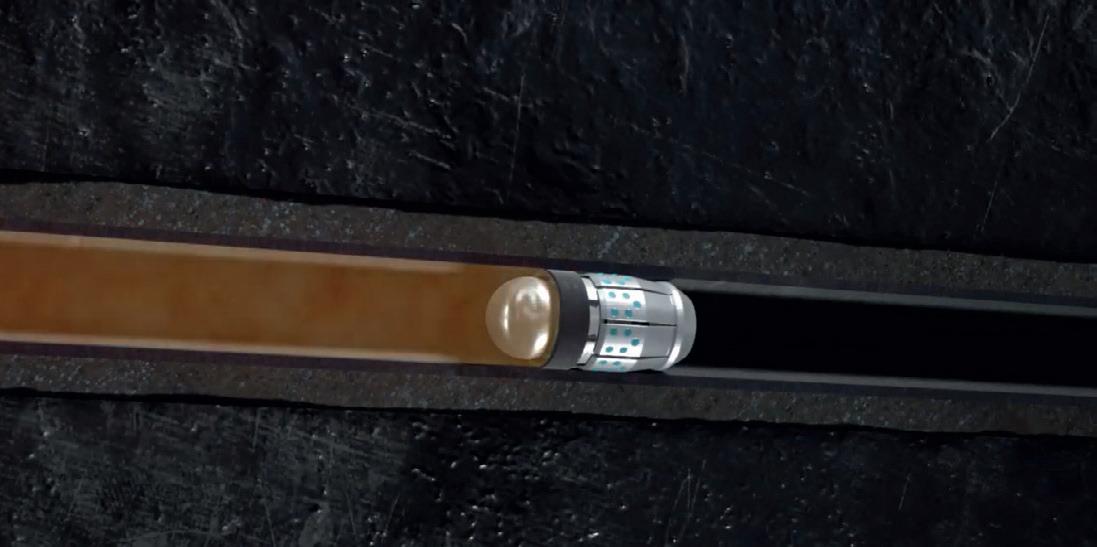
5 minute read
Pulling the plug on fracturing challenges
Jenny Darnell and Mohammed
Munawar, NOV, USA, detail a new dissolvable frac plug designed to solve modern downhole challenges.
Across the industry, extended reach wells are becoming the norm. An emphasis on minimising drilling and completions costs has pushed out lateral lengths, meaning fewer wells are needed to maintain the same amount of reservoir contact. Today’s longer laterals, enhanced drilling techniques and friction reduction tools have delivered new challenges to operators, though.
Modern wellbore challenges
Due to the constraint of deploying coiled tubing (CT) to reach the bottom of extended reach wells, it is impossible to deploy traditional composite plugs beyond a certain point. Difficult well geometries make friction reduction methods difficult, expensive and, sometimes, inefficient.
In plug-and-perf completion operations, there is a concern about the drill-out of composite plugs and remaining plug debris in the wellbore that could hinder future well completions, production and workover success. In addition to the potential for debris, operators have used different technologies to evaluate downhole conditions and perforation erosion, and been confronted with oversized casing erosion due to unreliable elements in frac plugs.
Operators have seen big holes around the frac plug area. The main problem is the seal around the rubber – after it is hit with high pressures the seal is penetrated, resulting in higher velocities around the slips area. Introducing proppant to the system in these areas will act like sand jet perforating, creating bigger holes in the casing and allowing the frac to go to one area rather than planned perforations.
To control the frac, it is essential to maintain the integrity of the casing.
While dissolvable frac plugs are available on the market, most do not have any back-up protection for the rubber for reliable isolation and require ideal wellbore conditions to dissolve completely, reintroducing the potential for debris-related slowdowns and inefficiencies. The challenge has been getting the right design and dissolvable technology to provide complete zonal isolation throughout the stimulation phase and reliably dissolve in an expected timeframe.

Solving frac plug issues
NOV’s VapRTM dissolvable frac plug’s design, downhole performance during frac treatment and customisable material together provide a solution to frac plug issues.
The plug has a metal-to-metal, expandable, dissolvable back-up system, is fully dissolvable and is designed to provide a dependable method for temporary zonal isolation during frac operations in vertical and horizontal completions.
Its compact, minimalistic design eliminates milling and post-frac cleanout, leaving no debris to remove from the well. The flug features 60% fewer parts than other products, leaving less material in the well to be dissolved, maximising the fluid area contact to ensure consistent material dissolution and eliminating remnant debris, which makes wellbore cleanout efficient and reliable.
Case studies
With many dissolvable plug options available on the market, operators look for a product that performs well in all categories:


ease of deployment, pump-down maximisation, pressure and mechanical resistance, and dissolvability, rather than a product that focuses solely on material selection. The VapR incorporates each of these metrics and provides strong operational performance while allowing significant dissolution improvements over previous generations of dissolvable frac plugs. An operator in the Utica Shale Play of the Appalachian Basin deployed multiple VapR dissolvable frac plugs, with the Figure 1. An emphasis on minimising drilling and completions costs has pushed out lateral lengths, deepest plug installation occurring meaning fewer wells are needed to maintain the same amount of reservoir contact. at 16 247 ft. The robust design allowed the operator to maximise efficiency in reducing water consumption and operation during pump-down operations, with rates of up to 19 barrels per minute (bpm) and 550 ft per minute line speed. During frac operations, 100% of the ball seat signatures were identified and no slipping of the frac plugs was observed, with a maximum frac rate of 90 bpm at 11 400 psi surface treating pressure. In one of the stages, operations were shut down due to an issue with the surface pumping equipment that left the plug subjected to corrosive downhole fluids for several hours. Despite this exposure, the frac plug continued to hold treatment pressure, maintaining zonal isolation and maximising performance. Upon cleanout, no downhole tags were observed for the plugs, confirming that they had completely dissolved in a challenging low-temperature environment. Operators experienced similar success in the Permian Basin when VapR plugs were used in three wells, covering more than 40 zones each. The plugs were set at targeted depths and maintained grip with no slippage in each well. The ball signatures at each stage were clear and improved fracturing efficiency with zero downtime. Operators placed approximately 200 pounds of frac plug material in each of the three wells. Upon cleanout, less than 20 pounds were recovered, confirming the efficiency of the plug’s design and enabling a smoother transition to the production phase. Figure 2. Multiple VapR frac plugs deployed in a well in the Appalachian Finally, the plug has been deployed on several occasions Basin. in Western Canada, where it is commonplace to pump acid for each zone for reservoir reasons. The ability for a dissolvable frac plug to seal in these scenarios is of vital importance, as most dissolvable materials are not acid-compatible. Operators have long struggled with leaks past dissolvable frac plugs. The VapR’s reliable seal/back-up system allowed these operators to place acid successfully and maintain zonal isolation and frac plug integrity during stimulation operations. Figure 3. The VapR dissolvable frac plug’s design, downhole performance during frac treatment and customisable material provide a solution to frac plug issues.
Conclusion
Operators have long struggled with the integrity of dissolvable frac plugs, leading to premature plug failure, inefficient operations and job site frustrations. The dissolvable frac plug developed by NOV provides reliability and strong performance, adding a modern twist to the industry’s solution to this issue.

Advertising with us

Learn more about our advertising opportunities
• Brand exposure • Lead generation • Premium packages










